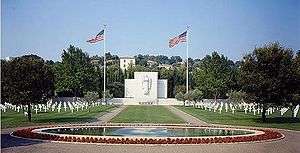Rhone American Cemetery and Memorial
Rhone American Cemetery and Memorial is a Second World War American military war grave cemetery, located within the city of Draguignan, 42 km (26 mi) north of Saint Tropez, in southern France. The cemetery, named for the Rhone river where most of those interred fought and died, was dedicated in 1956, and contains 858 American war dead and covers 12.5 acres (5.1 ha). It is administered by the American Battle Monuments Commission.[1]
| Rhone American Cemetery and Memorial | |
|---|---|
| American Battle Monuments Commission | |
 View of headstones and memorial | |
| Used for those deceased 1944–1946 | |
| Established | August 1944 (Completed 1956) |
| Location | 43°32′12″N 6°28′24″E near Draguignan, (Var), France |
| Designed by | Henry J. Toombs, Atlanta (Monument) A. F. Brinckerhoff, New York (Landscaping) |
| Total burials | 861 |
Unknowns | 62 |
| Commemorated | 294 |
| Burials by nation | |
United States: 861 | |
| Burials by war | |
World War II: 861 | |
| Statistics source: ABMC website | |
History
Those interred died mostly in the summer of 1944 during Operation Dragoon, the Allied invasion of southern France from the Mediterranean, which followed the Allied invasion of Normandy. This operation was designed to open a second beachhead and Allied combat zone in France, threatening the Axis units confronting the Normandy combat zone, and thus to accelerate the Allied drive into Western Europe. Those interred were mainly part of the U.S. Seventh Army, in particular the US 45th Infantry Division, the US 36th Infantry Division, and the US 3rd Infantry Division.
Layout
The cemetery, created 19 August 1944, has headstones arranged in straight lines, divided into four plots, and grouped around an oval pool. Small gardens are placed at each end of the cemetery which is overlooked by a chapel. Within the chapel are decorative mosaics, murals (by Austin M. Purves, Jr.) and sculptured figures. Between the chapel and the graves, a bronze relief map details US military operations in the region. On a wall of the terrace, 294 names of those missing in action are inscribed (rosettes mark those since recovered and identified).
References
- American Battle Monuments Commission. "Rhone American Cemetery". abmc.gov. Retrieved 26 February 2019.
- Sledge, Michael (2007) [2005]. Soldier Dead: How We Recover, Identify, Bury, and Honor Our Military Fallen. New York: Columbia University Press. pp. 208, 210. ISBN 9780231509374. OCLC 60527603.